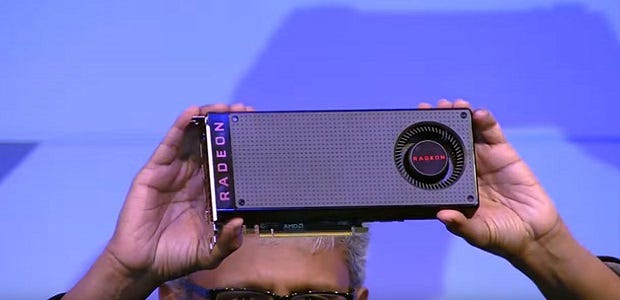AMD’s New $200/£175 VR-Friendly Gaming Graphics
VR for masses!
It’s not quite the full disclosure I’ve been hoping for, but AMD semi-announced its new AMD Radeon RX 480 graphics card at the Computex trade show, t’other day. Yep, it’s that new Polaris graphics tech we’ve mentioned previously and as predicted the new board isn’t a mega money irrelevance, like Nvidia’s GeForce GTX 1080. It’s affordable and, among other things, claims to deliver 3D rendering performance for virtually reality headsets that's comparable to $500 GPUs. VR for the masses, in other words. Sounds promising, but also strangely familiar…
Was it really eight long years ago that AMD rolled out the Radeon HD 4870? Just how long have I been doing this? Let’s not go there. Instead, let’s dwell on the intriguing similarity between the sales pitch for AMD’s latest Radeon RX 480 graphics card and that Radeon HD 4870 board of 2008.
Back then, AMD made a big noise about concentrating on mainstream gaming performance with a maximum price of about $300 / £250. The argument was that the $500+ boards are all very well, but hardly anyone can afford them and so they aren’t actually relevant.
It made sense, but seemed slightly suspicious coming off a difficult period for AMD, which included the basically borked Radeon HD 2900 series and the damage limitation exercise that was the Radeon HD 3800 series. Point being that while the 4800 series was a good GPU and while AMD’s argument about relevance had merit, the suspicion was that it was a strategy borne more of convenience than conviction.
 Sounds familiar: AMD employed a similarly democratic sales pitch for the Radeon HD 4870 of 2008...
Sounds familiar: AMD employed a similarly democratic sales pitch for the Radeon HD 4870 of 2008...
And so it duly proved, when AMD returned directly to the $500+ segment with the Radeon HD 5800 series and has remained active therein ever since. Until now, that is.
In that context, I’m somewhat skeptical of the altruistic aspects of AMD’s sales pitch for the new Radeon RX 480, which revolve around delivering 'VR for the masses'. Is that really what determined the spec of the new RX 480? Or is that a consequence of a need to adopt a more conservative strategy? Hold that thought, because I haven’t even told you what this thing looks like yet.
We don’t have all the specs but this is what we know: based on AMD's new Polaris graphics technology, also known as GCN 4.0, the RX 480 rocks in at 36 of AMDs compute units (CU), each of which, if you really must know, has hitherto contained a CU Scheduler, a Branch & Message Unit, four SIMD Vector Units (each 16-lane wide), four 64KiB VGPR files, one scalar unit, a 4 KiB GPR file, a local data share of 64 KiB, four Texture Filter Units, 16 Texture Fetch Load/Store Units and a 16 KiB L1 Cache.
That’s not a hugely helpful specification in the sense that it's largely gibberish and in so far as it makes any sense it's currently not known how a fancy new Polaris compute unit compares to AMD’s previous compute units. But in previous GCN chips, the key metric beyond all that other stuff was that a compute unit contained 64 of those shader thingies that make pixels look pretty.
A Radeon HD 390X, for instance, has 44 compute units and thus 2816 shaders, a Fury X has 64 compute units and 4,096 shaders. Thus, the new RX 480 probably / possibly has 2,304 shaders.
 Here's a man on a stage holding a card
Here's a man on a stage holding a card
The other hard number we have is the modest and conventional 256-bit memory bus. In other words, there’s no exotic HBM stacked memory malarkey going on here. Overall, AMD is claiming the 480 is capable of in excess of 5 TFLOPs of raw computation. That puts it in roughly the same ballpark as a Radeon HD 390X, which lists at twice the price of a new RX 480.
As for the need for a conservative strategy I implied earlier, that relates to the fact that this new graphics chip is being built by GlobalFoundries, which used to be part of AMD but was spun off a few years ago in one of AMD’s regular corporate restructuring drives.
Anyway, the point is that AMD used to have Taiwanese client chip production outfit TSMC make all its performance graphics chips. So it’s easy to imagine that AMD might not have fancied diving in with GlobalFoundries and its fancy new 14nm FinFET chip production tech with a really huge GPU. Instead, a more modestly proportioned GPU might have been prudent.
 And this is an exciting keynote slide
And this is an exciting keynote slide
Whatever, the big unresolved questions involve that new Polaris or GCN 4.0 architecture. Going by AMD claims, you might think the new RX 480 packs some kind of VR-specific rendering feature along the lines of Nvidia’s Simultaneous Multi-Projection, as seen in the new GeForce GTX 1080.
Time will tell. For now, and admittedly I am choosing to take a somewhat optimistic slant on all this, the new RX 480 has the possible makings of the most exciting card in years. If it truly has the performance a Radeon HD 390X or a GeForce GTX 980 for $200 / £175, that will be bloody lovely and I’ll probably buy one myself.
AMD says the new card goes on sales June 29th and if you operate around that price point, at the very least I'd hold fire on any purchases until then.
